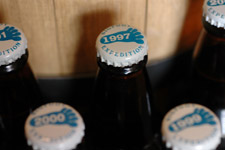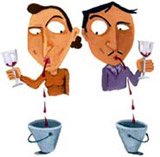Here’s one “real” (compared to the previous list) prediction for 2007 and one resolution.
The prediction: We may eventually grow tried of talking about “extreme beer (or beers),” but we won’t quit drinking them.
I’m sure that you are going to be reading (and therefore talking) more about them because Lew Bryson has written an article I’m anxious to read for Beer Advocate magazine, whose subscribers often take a walk on the extreme side.
That should provoke plenty of discussion, but it seems both polite and sensible to wait until the story is published to join in.
However here’s a little background to explain my upcoming resolution.
In researching his story Bryson sent a request to a forum run by the Brewers Association. He received dozens of responses within a day, including a lengthy one that Teri Fahrendorf of Steelhead Brewing posted. (You can read his request and her response here.)
Much conversation followed, among commercial brewers and among enthusiasts at several beer discussion sites. Also from Tomme Arthur of Lost Abbey, who wrote in his blog that “at no time have I ever considered what I do as a brewer to be extreme.” But he also points out that some spectacular beers have resulted from what Fahrendrof calls “testosterone-driven hop one-upmanship.”
Here’s where personal guilt sets in. These beers make good copy, and journalists live for good copy. I even won a an award (money, a trip) for writing about Imperial IPAs. More recently I wrote a story for All About Beer magazine about Sam Calagione, Arthur and three other brewers who made a trip to Belgium as part of Calagione’s research for his book, “Extreme Brewing.” Re-reading that story I see the words “extreme beers” used far too casually (by me).
The phrase has made for brilliant marketing since Jim Koch of Boston Beer began using it in the early 1990s. It’s easy to forget what a stir Sam Adams Triple Bock, then the world’s strongest beer at 17% abv, created when it debuted at the 1993 Great American Beer Festival.
“At the time, everyone was trying to make one new classic style. That’s what was driving innovation,” he said. “I wanted to step outside of that, to try to expand the boundaries of beer rather than expanding on traditional styles.”
And he wasn’t alone – in innovating or celebrating “extreme beer.”
But the term is double-edged because we’re not close to agreeing on a definition. When I type “extreme beers†I don’t mean they must be unbalanced, jammed with hops and overflowing with alcohol. More than 90% of the beer sold in this country is some form of international lager (Miller, Heineken, Corona, etc.). Folks, we’re not part of the mainstream. That IPA Fahrendorf brewed in 1990 is still extreme to most the population.
Roger Baylor (publican of Rich O’s Public House in New Albany, Ind.) has authored the motto for us all to live by: “Extremism in the defense of good beer is no vice.”
But, you know, I’m wrong to think everybody agrees. In her letter, Fahrendorf writes about brewers “more interested in balanced beers than in extreme beers.” That would imply the two are mutually exclusive. Clearly, we’ve got a failure to communicate.
Thus (finally) my resolution: I will not use the term “extreme beer” unless the conversation absolutely demands it, and when I do I will make it clear just what I mean.
 Here’s another prediction for 2007 I should have made: Vintage beers will command more attention.
Here’s another prediction for 2007 I should have made: Vintage beers will command more attention.  And so it has been written many times: Beer drinkers don’t spit.
And so it has been written many times: Beer drinkers don’t spit.